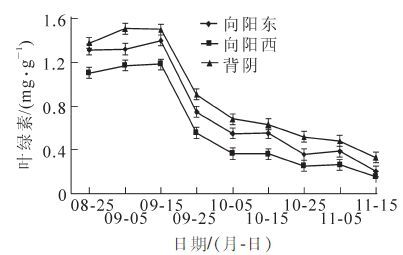-
落羽杉Taxodium distichum是古老的孑遗植物,具有生长快、干形直、材质好、耐腐朽、耐水湿、适应性广等优点,自被引种到欧洲、亚洲、非洲、大洋洲后,成为了这些地区生态环境建设、用材造林、园林景观应用的重要树种。落羽杉高大挺拔,树冠圆锥形,叶片春夏由嫩绿转为深绿,秋冬季转为红褐色,是园林造景较广泛的秋冬季红色叶树种。落叶树木秋季叶色变化与其叶片组织中和呈色相关的叶绿素、类胡萝卜素、生物碱类色素和黄酮类色素的含量有关[1-2] ,叶色变红是由于叶片中大量合成黄酮类色素中的花色素苷的结果[3],而花色素苷生物合成受多种因子诱导,如温度、光、营养供给、生长调控、代谢物以及组织的特殊发育阶段等[4-7],其中温度在叶色呈色过程中起着重要的调控作用。目前,针对落羽杉秋冬转色期叶色素和可溶性糖含量变化尚未见相关报道。本试验以落羽杉成龄植株为材料,研究秋冬转色期不同光照强度、不同气温、不同朝向、不同生境条件下落羽杉叶片叶绿素、花色素苷和可溶性糖含量的变化,为其园林造景应用提供理论支持。
-
以浙江农林大学东湖校区具有典型代表的成龄落羽杉植株为试材。选取树龄相近、长势良好、生长环境一致(地势开敞,光照充足)的植株,不同生境条件为陆生与水生2种类型。
-
试验于2012年8月下旬至11月上旬进行,取样时间为上午8:00-9:00,隔10 d采样测定1次。为探究落羽杉不同朝向叶片叶色变化,采样分向阳和背阴,向阳又分东西2个朝向,共3个处理,设重复3次·处理-1[8-9]。每次都在标记部位剪取适量叶片,取回后立即洗净、擦干,去掉主脉后剪碎、混匀,存放于4 ℃冰箱中保鲜,为叶绿素、花色素苷和可溶性糖的测定备用[10]。
-
取样当天用温湿度仪Testo 610测定当天温度,求出日平均气温。
-
采用丙酮浸提法测定叶绿素总含量[11]:取0.2 g样品于15 mL体积分数为80%的丙酮中,暗处浸提24 h至叶片变白,整个过程不断摇动;取上清液用UV-2550型紫外分光光度计测定645,652,663 nm处的吸光度值D(λ),以体积分数为80%丙酮作对照,计算叶绿素总质量分数。花色素苷相对含量测定采用盐酸浸提法[12]:取0.5 g样品于15 mL体积分数为1%的盐酸乙醇中,在暗处浸提24 h,期间不断摇动,以体积分数为1%盐酸乙醇作对照;以每克鲜质量在10 mL提取液中D(λ)0.1为1个色素单位,计算和比较花色素苷的相对含量。采用蒽酮比色法测定可溶性糖质量分数[13]。
-
将试验数据进行分类整理,实验数据测定均为3次重复,使用SPSS 11.5软件进行数据分析,Microsoft Excel 2003作图。
-
由图 1知:秋冬转色期落羽杉叶片叶绿素总质量分数呈先慢后快下降趋势,背阴面叶片叶绿素总质量分数显著高于向阳面,向阳东面高于向阳西面。这与西照太阳的光照强度强、光照时间长,引起西向的叶片叶绿素分解相对较快有关[14]。
-
由图 2知:秋冬转色期落羽杉花色素苷相对含量呈上升趋势,开始较为缓慢,11月5日之后迅速升高,树冠叶片迅速转为红棕色的时间与实地观察相吻合;从朝向来看,落羽杉花色素苷相对含量为向阳西面>向阳东面>背阴面。
-
由图 3知:落羽杉秋冬转色期花色素苷相对含量与叶绿素总质量分数比值呈逐渐上升趋势,且向阳西面>向阳东面>背阴面,11月5日之后比值迅速上升,此时叶子颜色最为亮丽鲜红,向阳西面叶片尤为明显,与实地观察到的阳面叶色转色较快相吻合,表明花色素苷相对含量与叶绿素总质量分数和它们的比值影响着落羽杉叶片的颜色变化。
-
由图 4知:落羽杉秋冬转色期可溶性糖质量分数呈逐渐上升趋势,由快到慢变化;不同朝向的可溶性糖质量分数为向阳西面>向阳东面>背阴面。
-
从表 1知:同株不同方位落羽杉叶片色素和可溶性糖质量分数存在一定的差异性;叶绿素总质量分数为背阴面>向阳东面>向阳西面,但它们间无显著差异;花色素苷相对含量为向阳西面>向阳东面>背阴面,且它们间呈显著差异;可溶性糖质量分数为向阳西面>向阳东面>背阴面,且它们间也呈显著差异。可见,光照强度、光照时间对叶绿素的分解和花色素苷的合成有直接的影响。
表 1 落羽杉不同方位花色素苷相对含量、可溶性糖和叶绿素总质量分数方差分析
Table 1. Analysis of variance of the anthocyanin, soluble sugar, chlorophyll content of Taxodium distichum in different positions of cypress
方位 花色素苷 /色素单位 可溶性糖 /(μg.g-1) 叶绿素 /(mg.g-1) 向阳东面 3.870 ± 0.679 aA 0.225 ± 0.011 aA 0.611 ± 0.071 aA 向阳西面 6.112 ± 0.408 bB 0.242 ± 0.005 bB 0.448 ± 0.023 aA 背阴 3.098 ± 0.595 aA 0.217 ± 0.007 aA 0.678 ± 0.049 aA 说明 : 表中数值 =平均数±标准差 ; 不同大写字母和小写字母分别表示在 0.01, 0.05 水平上的差异显著性 。 -
由图 5知:试验过程中日平均气温总体呈现下降趋势。由表 2知:温度与各朝向叶片花色素苷相对含量呈显著(P<0.05)或极显著(P<0.05)负相关,与可溶性糖质量分数呈负相关,与叶绿素总质量分数呈现极显著正相关。
表 2 秋冬转色期气温与落羽杉花色素苷相对含量、可溶性糖质量分数、叶绿素总质量分数相关系数
Table 2. Correlation coefficients between temperature and anthocyanin or soluble sugar content or chlorophyll content of Taxodium distichum during the color-changing period of cypress in autumn and winter
方位 平均温度与花色素苷 平均温度与可溶性糖 平均温度与叶绿素 向阳东面 -0.643** -0.120 0.763** 向阳西面 -0.510* -0.855 0.726** 背阴 -0.480* -0.564 0.708** 说明 : * 表示 P<0.05; ** 表示 P<0.01。 -
由图 6知:秋冬转色期陆生与水生落羽杉叶片叶绿素总质量分数呈下降趋势,且水生落羽杉叶绿素总质量分数下降较陆生落羽杉快;水生落羽杉叶绿素总质量分数高于陆生落羽杉。这与胡永红等[15]关于秋色叶叶色变化的研究结果相吻合,空气相对湿度高对叶绿素的降解和花色素苷的合成有促进作用。
-
由图 7知:陆生与水生落羽杉秋冬转色期花色素苷相对含量呈上升趋势,11月5日后上升加快,与实地观察到的落羽杉叶片迅速转为红棕色时间相一致;水生落羽杉花色素苷相对含量高于陆生落羽杉,与实地观察水生落羽杉红叶观赏期较陆生落羽杉长相吻合。
-
由图 8知:陆生与水生落羽杉秋冬转色期可溶性糖质量分数呈上升趋势,先快后慢;11月5日之后,可溶性糖质量分数变化较慢,趋于稳定;水生落羽杉可溶性糖质量分数高于陆生落羽杉。
-
由表 3知:秋冬转色期落羽杉花色素苷相对含量与叶绿素总质量分数呈负相关,其中陆生落羽杉为显著负相关、水生落羽杉为极显著负相关,而与可溶性糖质量分数的相关性不显著。
表 3 秋冬转色期落羽杉花色素苷相对含量与叶绿素总质量分数及可溶性糖质量分数的相关系数
Table 3. Correlation coefficients between anthocyanin and chlorophyll or soluble sugar content of Taxodium distichum during the color-changing period in autumn and winter
取样 相关系数 花色素苷与叶绿素 花色素苷与可溶性糖 陆生落羽杉 -0.376* 0.493 水生落羽杉 -0.371** 0.552 说明 : * 表示 P<0.05; ** 表示 P<0.01。 -
光照强度、光质和光照时数等对彩叶植物花色素苷的合成及调节相关酶的活性起着重要作用[16],光照可以使叶绿素、花色素苷的含量及比例发生变化,对叶片的颜色变化产生影响。秋冬转色期落羽杉同株不同方位叶片叶绿素呈下降趋势,花色素苷相对含量与可溶性糖质量分数均呈上升趋势;不同方位叶片花色素苷相对含量与可溶性糖质量分数差异性显著(P<0.05);不同方位花色素苷相对含量为向阳西面>向阳东面>背阴面,说明向阳西面光照时数长、光照强度强对花色素苷的合成有利。这与Saure[17]认为入秋后随着叶绿素的降解,花色素苷合成加快的研究结果相一致,叶绿素的降解物可能对于花色素苷的形成起到活化作用。
秋冬季低温可以诱导植物体内花色素苷的合成,光合色素在低温下合成受阻,从而引起植物叶色变化[18-19]。唐前瑞等[20]认为叶片中花色素苷的合成和衰老期间糖分的积累有相关关系。实验结果显示,落羽杉秋冬转色期叶片花色素苷和可溶性糖质量分数均呈上升趋势;日平均气温与叶绿素总质量分数呈正相关,与花色素苷相对含量呈显著负相关。当温度下降至17.7 ℃时,花色素苷相对含量急剧上升,达到4.75(色素单位),实验结果证明低温有利于花色素苷的积累。
试验结果与实地观察显示,水生落羽杉秋冬转色期、彩叶观赏期较陆生落羽杉的时间长,如将落羽杉配植在水边或水中,其秋色叶更能展现景观效果。
Ecological physiology of Taxodium distichum leaves color changes in autumn and winter
-
摘要: 为探讨落羽杉Taxodium distichum秋冬季叶色变化规律, 研究落羽杉在不同光照、温度和不同生境条件下叶色转变时的生态生理变化, 以落羽杉成龄植株为材料, 于2012年8月下旬至11月中旬用分光光度计测定其不同方位与不同生境条件下叶片叶绿素总质量分数、花色素苷相对含量和可溶性糖质量分数。结果表明:秋冬转色期落羽杉叶片叶绿素总质量分数呈下降趋势, 树冠背阴面叶片叶绿素总质量分数明显高于向阳面, 向阳东面高于向阳西面;花色素苷相对含量呈上升趋势, 11月5日之后显著升高;可溶性糖质量分数呈上升趋势;日平均气温与花色素苷相对含量、可溶性糖质量分数间呈负相关;水生落羽杉叶绿素总质量分数、花色素苷相对含量、可溶性糖质量分数均高于陆生落羽杉, 水生落羽杉红叶观赏期较陆生落羽杉长, 它们的花色素苷相对含量与叶绿素总质量分数呈显著负相关(P<0.05)。光照充足条件下, 生长在水中的落羽杉红叶期要长于陆生的, 且有较好的整体观赏性。Abstract: To explore the rule of cypress leaf color changes in autumn and winter, and study the physiological characteristics under different illumination, temperature and habitat conditions, the mature cypress trees' (Taxodium distichum) variations of chlorophyll, anthocyanin and soluble sugar content in its leaves were measured during the color-changing period from late August to early November by spectrophotometry. The results indicated that the chlorophyll content descended gradually. The chlorophyll content in the leaves in the shady side was significantly higher than that in the sunny side, and that in the east of the sunny side was significantly higher than the west. The anthocyanin content kept ascending slowly before November 5th and increased significantly since then. The soluble sugar content increased gradually. During the experiment, there was a negative correlation between daily average temperature and anthocyanin content, or soluble sugar content. Chlorophyll, anthocyanin and soluble sugar contents of cypress which grown in the water were less than those grown in the field. The red-leaf period of cypress trees which were grown in the water was longer than those grown in the field, and there was a significantly negative correlation(P<0.05)between anthocyanin and chlorophyll content. Under the adequate sunlight, red-leaf period of cypress trees grown in the water was longer than those grown in the field, and the former had higher ornamental values.
-
表 1 落羽杉不同方位花色素苷相对含量、可溶性糖和叶绿素总质量分数方差分析
Table 1. Analysis of variance of the anthocyanin, soluble sugar, chlorophyll content of Taxodium distichum in different positions of cypress
方位 花色素苷 /色素单位 可溶性糖 /(μg.g-1) 叶绿素 /(mg.g-1) 向阳东面 3.870 ± 0.679 aA 0.225 ± 0.011 aA 0.611 ± 0.071 aA 向阳西面 6.112 ± 0.408 bB 0.242 ± 0.005 bB 0.448 ± 0.023 aA 背阴 3.098 ± 0.595 aA 0.217 ± 0.007 aA 0.678 ± 0.049 aA 说明 : 表中数值 =平均数±标准差 ; 不同大写字母和小写字母分别表示在 0.01, 0.05 水平上的差异显著性 。 表 2 秋冬转色期气温与落羽杉花色素苷相对含量、可溶性糖质量分数、叶绿素总质量分数相关系数
Table 2. Correlation coefficients between temperature and anthocyanin or soluble sugar content or chlorophyll content of Taxodium distichum during the color-changing period of cypress in autumn and winter
方位 平均温度与花色素苷 平均温度与可溶性糖 平均温度与叶绿素 向阳东面 -0.643** -0.120 0.763** 向阳西面 -0.510* -0.855 0.726** 背阴 -0.480* -0.564 0.708** 说明 : * 表示 P<0.05; ** 表示 P<0.01。 表 3 秋冬转色期落羽杉花色素苷相对含量与叶绿素总质量分数及可溶性糖质量分数的相关系数
Table 3. Correlation coefficients between anthocyanin and chlorophyll or soluble sugar content of Taxodium distichum during the color-changing period in autumn and winter
取样 相关系数 花色素苷与叶绿素 花色素苷与可溶性糖 陆生落羽杉 -0.376* 0.493 水生落羽杉 -0.371** 0.552 说明 : * 表示 P<0.05; ** 表示 P<0.01。 -
[1] 祝钦泷. 彩叶草叶色形成相关的花色素苷生物合成途径的分子调控研究[D]. 重庆:西南大学, 2007. ZHU Qinlong. Studies on the Molecular Regulation of the Anthocyanin Biosynthesis Related to Leaf Color of Solenostemon scutellarioides[D]. Chongqing:Southwestern University, 2007. [2] VAKNIN H, BARAKIVA A, OVADIA R, et al. Active anthocyanin degradation in Brunfelsia calycina (yesterday-today-tomorrow) flowers[J]. Planta, 2005, 222(1):19-26. [3] KIM J S, LEE B H, KIM S H, et al. Responses to environmental and chemical signals for anthocyanin biosynthesis in non-chlorophyllous corn(Zear mays L.) leaf[J]. J Plant Biol, 2006, 49(1):16-25. [4] BAN Y, KONDO S, UBI B E, et al. UDP-sugar biosynthetic pathway:contribution to cyanidin 3-galactoside biosynthesis in apple skin[J]. Planta, 2009, 230(5):871-881. [5] AHMED N, MAEKAWA M, NODA K. Anthocyanin accumulation and expression pattern of anthocyanin biosynthesis genes in developing wheat coleoptiles[J]. Biol Plant, 2009, 53(2):223-228. [6] 张剑亮. 观赏向日葵花色形成的机理研究[D]. 福州:福建农林大学, 2008. ZHANG Jianliang. Study on the Formation of Flower Color from Ornamental Sunflower (Helianthus annuus)[D]. Fuzhou:Fujian Agriculture and Forestry University, 2008. [7] 孙明霞, 王宝增, 范海, 等. 叶片中的花色素苷及其对植物适应环境的意义[J]. 植物生理学通讯, 2003, 39(6):688-694. SUN Mingxia, WANG Baozeng, FAN Hai, et al. Anthocyanins of leaves and their environmental significance in plant stress responses[J]. Plant Physiol Commun, 2003, 39(6):688-694. [8] 于晓南, 张启翔. 观赏植物的花色素苷与花色[J]. 林业科学, 2002, 38(3):147-153. YU Xiaonan, ZHANG Qixiang. Anthocyanin in ornamental plant and color express[J]. Sci Silv Sin, 2002, 38(3):147-153. [9] 陈继卫, 沈朝栋, 贾玉芳, 等. 鸡爪槭转色期叶色变化生理研究[J]. 核农学报, 2010, 24(1):171-175. CHEN Jiwei, SHEN Chaodong, JIA Yufang, et al. Physiological changes of Japanese maple (Acer palmatum Thunb) leaves during color-changing period[J]. J Nucl Agric Sci, 2010, 24(1):171-175. [10] 马海燕, 李永, 郑春雷, 等. 4种植物生长调节剂对切花菊保鲜效果和生理作用的影响[J]. 河南农业大学学报, 2012, 46(3):278-283. MA Haiyan, LI Yong, ZHENG Chunlei, et al. Influence of four plant growth regulators on vase life and physiological action of cut chrysanthemum[J]. J Henan Agric Univ, 2012, 46(3):278-283. [11] 李得孝, 郭月霞, 员海燕, 等. 玉米叶绿素含量测定方法研究[J]. 中国农业通报, 2005, 21(6):153-155. LI Dexiao, GUO Yuexia, YUAN Haiyan, et al. Determined methods of chlorophyll from maize[J]. Chin Agric Sci Bull, 2005, 21(6):153-155. [12] ZHANG Feng, WANG Jianhua, YU Songlie, et al. Study on daily changes of photosynthesis in Cynanchum bungei[J]. Acta Bot Boreal-Occident Sin, 2005, 25(2):288-292. [13] 路文静, 李奕松. 植物生理学实验教程[M]. 北京:中国林业出版社, 2012:54-57. [14] 陈继卫, 沈朝栋, 贾玉芳, 等. 红枫秋冬转色期叶色变化的生理特性[J]. 浙江大学学报:农业与生命科学版, 2010, 36(2):181-186. CHEN Jiwei, SHEN Chaodong, JIA Yufang, et al. Physiological changes of maple (Acer palmatum ‘Atropurpureum’) leaves during the color-changing period in autumn and winter[J]. J Zhejiang Univ Agric & Life Sci, 2010, 36(2):181-186. [15] 胡永红, 秦俊, 蒋昌华, 等. 上海地区秋色叶成因的调查与分析[J]. 东北林业大学学报, 2004, 32(5):84-86. HU Yonghong, QIN Jun, JIANG Changhua, et al. Investigation and analysis on cause of forming autumn-color leaf in Shanghai[J]. J Northeast For Univ, 2004, 32(5):84-86. [16] 李红秋, 刘石军. 光照强度和光照时间对色叶树种叶色变化影响[J]. 植物研究, 1998, 18(2):194-205. LI Hongqiu, LIU Shijun. Effects of light intensity and illumination time on leaf color variations of colored leaf trees[J]. Bull Bot Res, 1998, 18(2):194-205. [17] 于晓南, 张启翔. 彩叶植物多彩形成研究进展[J]. 园艺学报, 2000, 27(增刊):533-538. YU Xiaonan, ZHANG Qixiang. Review of researches on leaf color changing of color leafed plants[J]. Acta Hort Sin, 2000, 27(supp):533-538. [18] 潘增光, 王国宾, 李奎明, 等. 新红星苹果果实着色期几种色素含量变化及其相关性(简报)[J]. 植物生理学通讯, 1996, 32(5):347-349. PAN Zengguang, WANG Guobin, LI Kuiming, et al. Change of some pigment contents and their correlation skin coloring stage in ‘Starkrimson’ apple[J]. Plant Physiol Commun, 1996, 32(5):347-349. [19] 费芳, 王慧颖, 唐前瑞. 温度对红花檵木叶色的影响研究[J]. 湖南理工学院学报:自然科学版, 2008, 21(2):88-90. FEI Fang, WANG Huiying, TANG Qianrui. Study on the impact of temperature on Loropetalum chinese var. rubrum leaves color[J]. J Hunan Inst Sci Technol Nat Sci Ed, 2008, 21(2):88-90. [20] 唐前瑞, 陈德富, 陈友云, 等. 红花檵木叶色变化的生理生化研究[J]. 林业科学, 2006, 42(2):111-115. TANG Qianrui, CHEN Defu, CHEN Youyun, et al. Changes of physiology and biochemistry during leaf color transformation in Loropetalum chinense var. rubrum[J]. Sci Silv Sin, 2006, 42(2):111-115. -

-
链接本文:
https://zlxb.zafu.edu.cn/article/doi/10.11833/j.issn.2095-0756.2014.02.021







 下载:
下载:









